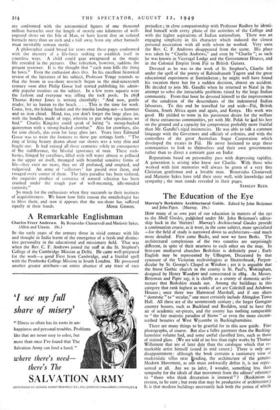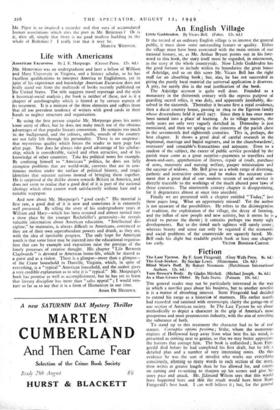The Education of the Eye
Murray's Berkshire Architectural Guide. Edited by John Betjeman and John Piper. (Murray. 18s.)
How many of us owe part of our education in matters of the eye to the Shell Guides, puhlished under Mr. John Betjeman's editor- ship back in the 'thirties! Murray's Architectural Guides provide a continuation course, as it were, in the same subject, more specialised —for the field of study is narrowed down to architecture—and much more detailed. First came Bucks, and now we have Berks. The architectural complexions of the two counties are surprisingly different, in spite of their nearness to each other on the map. In first-rate mediaeval churches Berkshire is definitely poor ; Early English may be represented by Uffington, Decorated by that cynosure of the Victorian ecclesiologists at Shottesbrook, Perpen- dicular by St. George's Chapel at Windsor ; yet it is arguable that the finest Gothic church in the county is St. Paul's, Wokingham, designed by Henry Woodyer and consecrated in 1864. As Messrs. Betjeman and Piper say, it is chiefly as a county of domestic archi- tecture that Berkshire stands out. Among the buildings in this category that rank highest as works of art are Coleshill and Ashdown Houses ; once there was Hamstead Marshall, and if one alters " domestic " to " secular," one must certainly include Abingdon Town Hall. All these are of the seventeenth century ; the larger Georgian country houses, such as Buckland and Basildon, tend to have the air of academic set-pieces, and the county has nothing comparable to "the fair majestic paradise of Stowe" or even the more circum- scribed beauties of West Wycombe in Buckinghamshire.
There are many things to be grateful for in this new guide. Fine photographs, of course. But also a fuller gazetteer than the Bucking- hamshire volume had, and some useful classified lists, such as those of stained glass. (We arc told of no less than eight works by Thomas Willement that are of later date than the catalogue which that re- markable artist himself issued in mid career.) There is only one disappointment : although the book contains a cautionary view 01 modernistic villas near Illeading, the architecture of the genuine Modern Movement, as one must awkwardly define it, is not repre- sented at all. Are we to infer, I wonder, something less than sympathy for the ideals of that movement from the editors' reference to "those who think decoration is immoral " ? (Ruskinism reverse, to be sure ; but even that may be productive of architecture.) Is it that modern buildings necessarily lack both the patina of which Mr. Piper is so inspired a recorder and that aura- of accumulated human associations which stirs the poet in Mr. Betjeman ? Or is it, after all, simply that there is no good modern building in the whole of Berkshire ? I really fear that it may be.
MARCUS WHIFFEN.































 Previous page
Previous page